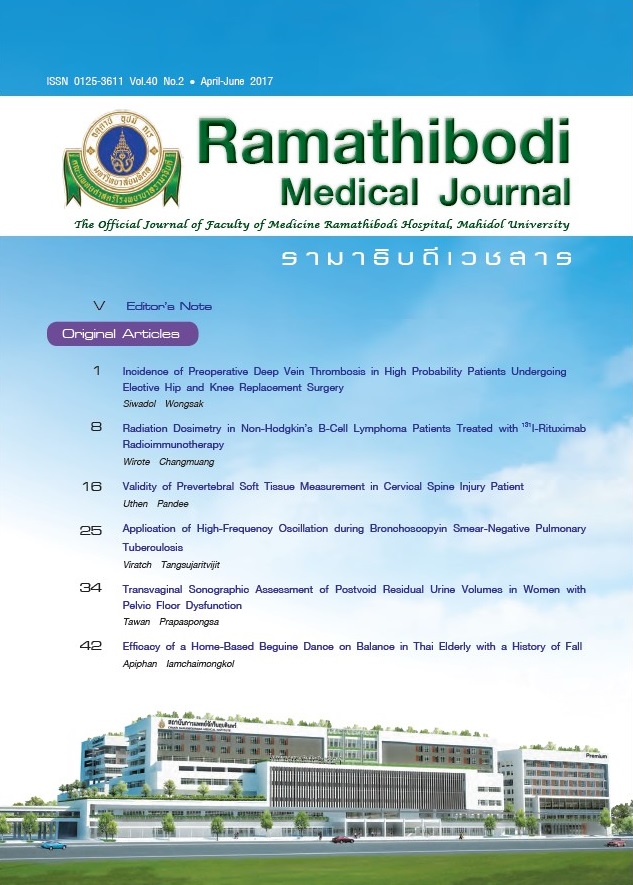Transvaginal Sonographic Assessment of Postvoid Residual Urine Volumes in Women with Pelvic Floor Dysfunction
Keywords:
transvaginal ultrasonography, postvoid residual urine volumes, pelvic floor dysfunctionAbstract
Objective: To evaluate the correlation between postvoid residual urine volumes assessed by transvaginal ultrasonography and by catheterization in women that had pelvic floor dysfunction.
Methods: Measurement of postvoid residual urine volume was performed in 78 women who presented with pelvic floor dysfunction at the Urogynaecology Clinic, Ramathibodi Hospital. Transvaginal ultrasonography was used to measure three diameters of the bladder in two perpendicular planes. Postvoid residual urine volumes were calculated using the formula “postvoid residual volume = (height x width x depth) x 0.7” and these volumes were compared with those obtained from catheterization in each patient.
Results: Pelvic organ prolapse, stress urinary incontinence and mixed urinary incontinence were found in 53.8%, 46.2% and 41.0% of women, respectively. The postvoid residual urine volumes assessed by transvaginal ultrasonography were significantly correlated with the catheterized urine volumes. These two methods had high correlation coefficient of 0.99 (P < 0.001). The mean difference of bladder volume from the two assessments was 6.02 ml (95% CI, 7 - 19)
Conclusions: The transvaginal ultrasonography is a non-invasive technique that has high correlation with catheterized urine volume when was used to assess postvoid residual urine volumes in women with pelvic floor dysfunction.
References
Messelink B, Benson T, Berghmans B, et al. Standardization of terminology of pelvic floor muscle function and dysfunction: report from the pelvic floor clinical assessment group of the international continence society. Neurourol Urodyn. 2005;24(4):374-80.
Lawrence JM, Lukacz ES, Nager CW, Hsu JW, Luber KM. Prevalence and co-occurrence of pelvic floor disorders in community-dwelling women. Obstet Gynecol. 2008;111(3):678-85. doi:10.1097/AOG.0b013e3181660c1b.
Cetinkaya SE, Dokmeci F, Dai O. Correlation of pelvic organ prolapse staging with lower urinary tract symptoms, sexual dysfunction, and quality of life. Int Urogynecol J. 2013;24(10):1645-50. doi:10.1007/s00192-013-2072-4.
Haylen BT, de Ridder D, Freeman RM, et al. An International Urogynecological Association (IUGA)/International Continence Society (ICS) joint report on the terminology for female pelvic floor dysfunction. Int Urogynecol J. 2010;21(1):5-26. doi:10.1007/s00192-009-0976-9.
Haylen BT, Lee J, Logan V, Husselbee S, Zhou J, Law M. Immediate postvoid residual volumes in women with symptoms of pelvic floor dysfunction. Obstet Gynecol. 2008;111(6):1305-12. doi:10.1097/AOG.0b013e31817615b2.
Tseng LH, Liang CC, Chang YL, Lee SJ, Lloyd LK, Chen CK. Postvoid residual urine in women with stress incontinence. Neurourol Urodyn. 2008;27(1):48-51.
Abrams P, Cardozo L, Fall M, et al. The standardisation of terminology in lower urinary tract function: report from the standardisation sub-committee of the International Continence Society. Urology. 2003;61(1):37-49.
Tenke P, Kovacs B, Bjerklund Johansen TE, Matsumoto T, Tambyah PA, Naber KG. European and Asian guidelines on management and prevention of catheter-associated urinary tract infections. Int J Antimicrob Agents. 2008;31(Suppl 1):S68-78.
Barford JM, Anson K, Hu Y, Coates AR. A model of catheter-associated urinary tract infection initiated by bacterial contamination of the catheter tip. BJU Int. 2008;102(1):67-74. doi:10.1111/j.1464-410X.2008.07465.x.
Kim MK, Park K. Unusual complication of urethral catheterization: a case report. J Korean Med Sci. 2008;23(1):161-2. doi:10.3346/jkms.2008.23.1.161.
Griffiths CJ, Murray A, Ramsden PD. Accuracy and repeatability of bladder volume measurement using ultrasonic imaging. J Urol. 1986;136(4):808-12.
Amole AO, Kuranga SA, Oyejola BA. Sonographic assessment of postvoid residual urine volumes in patients with benign prostatic hyperplasia. J Natl Med Assoc. 2004;96(2):234-9.
Goode PS, Locher JL, Bryant RL, Roth DL, Burgio KL. Measurement of postvoid residual urine with portable transabdominal bladder ultrasound scanner and urethral catheterization. Int Urogynecol J Pelvic Floor Dysfunct. 2000;11(5):296-300.
Haylen BT, Frazen MI, Sutherst JR, West CR. Transvaginal ultrasound in the assessment of bladder volumes in women. Br J Urol. 1989;63(2):149-51.
Farrell T, Leslie JR, Chien PFW, Agustsson P. The reliability and validity of three dimentional ultrasound volumetric measurements using an in vitro balloon and in vivo uterine model. BJOG. 2001;108(6):573-82.
Choe JH, Lee JY, Lee KS. Accuracy and precision of a new portable ultrasound scanner, the BME-150A, in residual urine volume measurement: a comparison with the Bladder Scan BVI 3000. Int Urogynecol J Pelvic Floor Dysfunct. 2007;18(6):641-4.
Lukasse M, Cederkvist HR, Rosseland LA. Reliability of an automatic ultrasound system for detecting postpartum urinary retention after vaginal birth. Acta Obstet Gynecol Scand. 2007;86(10):1251-5.
Lertbunnaphong T, Inthasorn P, Boriboonhirunsarn D, Chuchotirot M, Russameecharoen K, Phattanachindakun B. Transabdominal ultrasound in the assessment of postvoid residual urine volume in patients after hysterectomy. J Med Assoc Thai. 2006;89(Suppl 4):S152-7.
Yip SK, Sahota DS, Chang AM. A probability model for ultrasound estimation of bladder volume in the diagnosis of female urinary retention. Gynecol Obstet Invest. 2003;55(4):235-40.
Yip SK, Sahota D, Chang AM. Determining the reliability of ultrasound measurements and the validity of the formulae for ultrasound estimation of postvoid residual bladder volume in postpartum women. Neurourol Urodyn. 2003;22(3):255-60.
Yip SK, Fung TY, Chung TK. Ultrasonographic estimation of postpartum postvoid residual bladder volume: a comparison between transabdominal and transvaginal ultrasonography. Int Urogynecol J Pelvic Floor Dysfunct. 1998;9(1):9-12.
Haylen BT. Residual urine volume in a normal female population: application of transvaginal ultrasound. Br J Urol. 1989;64(4):347-9.
Poston GJ, Joseph AE, Riddle PR. The accuracy of ultrasound in the measurement of changes in bladder volume. Br J Urol. 1989;55(4):361-3.
Gehrich A, Stany MP, Fischer JR, Buller J, Zahn CM. Establishing a mean postvoid residual volume in asymptomatic perimenopausal and postmenopausal women. Obstet Gynecol. 2007;110(4):827-32.
Downloads
Published
How to Cite
Issue
Section
License
Copyright (c) 2017 By the authors. Licensee RMJ, Faculty of Medicine Ramathibodi Hospital, Mahidol University, Bangkok, Thailand

This work is licensed under a Creative Commons Attribution-NonCommercial-NoDerivatives 4.0 International License.













